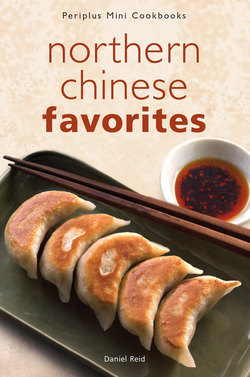Читать книгу Mini Northern Chinese Favorites - Reid - Страница 4
На сайте Литреса книга снята с продажи.
ОглавлениеThe evolution of northern Chinese cuisine has been strongly influenced by the relatively dry, cold climate and wind-swept steppes of northern China. Unlike the lush green regions of the southern and eastern coastal provinces, where rice is the major staple, wheat and millet are the main grains used in northern cooking. Wheat-based dishes such as noodles, steamed and baked buns, boiled and fried dumplings, and various breads and pancakes appear frequently on traditional northern menus, while millet gruel (“congee”) is one of the most ancient of all food items in northern China, long pre-dating both rice and wheat. A variety of the most popular northern wheat dishes are included among the recipes in this book.
Besides noodles, dumplings and other “pasta” dishes, northern Chinese are very fond of “cold cut” plates prepared with various braised or boiled meats, soft or pressed tofu, as well as a wide range of raw or lightly poached vegetables. Cold cut plates are usually presented as appetizers at the beginning of a meal. Sometimes, they are included as additional main dishes in a meal. Cold cut plates are also often served as “drinking food” (xia jiu cai) accompanying wine, beer or spirits—when drinking rather than eating is the main event. Many northerners like to compose whole meals consisting entirely of these tasty leng pan (literally “cold plates”).
Red meats are used more frequently and in greater quantity in northern food than in any other regional Chinese cuisine. This is due partly to the relative scarcity of fresh vegetables in the arid north and to the warming nature of meat dishes, which were traditionally consumed as fuel to help keep the body warm in cold northern climates. Lamb and beef, rather than pork, are the most popular choices in northern cuisine, due to the herding traditions of the Mongols and other neighboring nomadic tribes on the northern steppes, as well as the influence of Moslem minorities, who generally avoid pork. A few pork dishes do, however, appear on cosmopolitan Beijing menus.
Garlic—lots of garlic—is the favorite seasoning in northern kitchens, followed closely by leeks, spring onions, garlic chives, coriander leaves and of course the great common denominator of all Chinese kitchens—ginger. Chili was not much used in northern cooking during olden times, but is often included in northern recipes today and may be added to almost any recipe. In most northern sauces, the strong, smoky flavor of sesame oil predominates, usually in conjunction with soy sauce and salt and often further embellished with balancing accents of vinegar and sugar.
Northern food is generally regarded as an earthy, no-frills form of cooking in Chinese cuisine and therefore it lends itself well to quick and easy preparation at home. Its unpretentious style and frequent reliance on meat and wheat also make northern-style cooking familiar to Westerners who have not yet become accustomed to the refined cuisines of the south and this makes northern dishes a suitable choice when inviting Western friends to dinner in a Chinese home.
